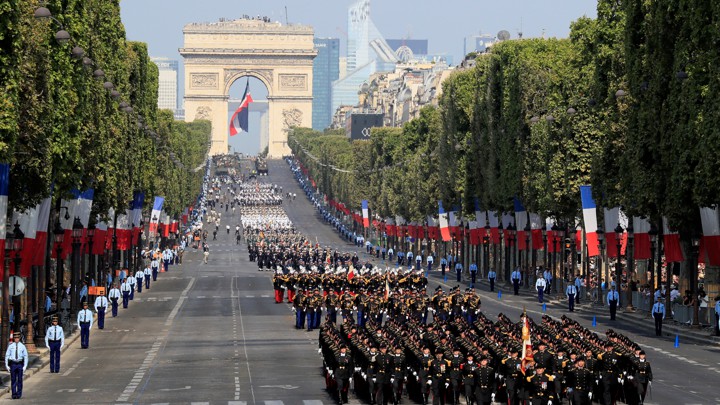The Virtues of Nationalism
We all have books that have influenced how we make sense of the world. One of my favorites is Polyethnicity and National Unity in World History, a short book by the Canadian American historian William McNeill that was first published in 1985. I recently learned that McNeill died in the summer of 2016, not long after Britain voted to leave the European Union and shortly before Donald Trump was elected president of the United States. It occurs to me that McNeill would have had a great deal to say about the reassertion of nationalism around the world, and I regret that he is not here to share his thoughts with us. This is not because I expect that McNeill would echo my own beliefs—indeed, I am confident he would not—but rather because his work might help reorient our perspective.
Though McNeill was very much a skeptic of nationalism, he taught me, in a roundabout way, to appreciate its virtues. Critics of nationalism often point to the fact that it is a relatively novel doctrine, and they’re not wrong to do so. What they tend to neglect, however, is that the same can be said of nationalism’s chief rival: the ideal of a cultural pluralism that is bereft of hierarchy. In liberal circles, “nationalism” is typically understood as a divisive, exclusionary force, usually in implicit contrast with some form of cultural pluralism, and so to identify as a nationalist is to declare oneself a chauvinist.
But as McNeill suggests, nationalism can be understood as a unifying alternative to a society built on polyethnic hierarchy, in which a series of hereditary ethnic castes live together in uneasy peace, usually with some dominating the others. It is polyethnic hierarchy that has been the norm throughout modern history, not national unity or egalitarian pluralism. One could argue that the dream of pluralism without hierarchy is at least as chimerical as that of an egalitarian nationalism built on the melting and fusing together of once-distinct groups, if not far more so. McNeill’s stylized history gives us a sense of what we’re up against as we try to build decent and humane societies amidst entrenched ethnic divisions, and why so many modern thinkers have embraced the politics of national unity.
Until around the mid-18th century, McNeill argued, ethnic-political unity in major civilizations from Europe to the Mediterranean to the Asian steppe “was often illusory and always fragile.” The 19th-century ideal of the homogenous nation-state, which took off with particular intensity in revolutionary France, was something of a historical anomaly, one that the epic demographic and ideological shifts of the bloody 20th century would begin to erase. Today we may find ourselves at another major turning point in the relationship between state and ethnos.
McNeill cites three factors that obstructed the formation of stable and cohesive national identities for much of recorded history. First, in the premodern period, the continuous conquest and reconquest of vast territories by rival bands of military nomads competing for resources ensured continuous ethnic mixing and upheaval, especially in major population centers. “The rise of nomadry as a way of life,” McNeill writes, “acted on the peoples of Eurasia like an enormous gristmill, grinding the peasant majority exceedingly hard since it was they who suffered plunder and paid taxes, sustaining their military masters and all the other occupational specialists who congregated in cities and maintained the arts and skills of civilization.”
The second fact of premodern and early-modern life that forced urban ethnic mixing was the prevalence of fatal infectious diseases in populous areas. Mortality rates were so high that cities were not able to sustain their population through reproduction alone, and while some of the labor shortage could be made up by organic migration from nearby rural areas, political elites more often than not resorted to the importation of ethnic “others” as slaves, helots, or serfs from their imperial peripheries. Even the classical city-states of Athens and Rome, sometimes regarded as model egalitarian liberal republics, would soon transform into mighty empires whose capitals were flooded with foreign-born ethnic outsiders who were politically and economically subordinate to the dominant class of Greek or Roman citizens.
Finally, different ethnic groups interacted with one another vigorously because of widespread economic exchange and missionary activity. Trade “gave birth to permanent communities of aliens in major urban centers,” and “the rise of portable and universal religions … provided an effective cultural carapace for trade diasporas, insulating them from their surroundings in matters of faith and family as never before.” The result is that across Eurasia, while ethnic homogeneity was common in the rural countryside, the cities that acted as the seats of political power and civilizational progress were defined by polyethnicity, or a hierarchy of ethnic castes. With notable exceptions, including in the Empire of Japan and early Macedon, few political elites “assumed that uniformity was desirable or that assimilation to a common style of life or pattern of culture was either normal or possible.”
According to McNeill, the first real approximations of national states in Europe—that is, political units that corresponded with ethnic boundaries—began to form in the late Middle Ages: “France and England, along with a fringe of others: Denmark, Sweden, Hungary, Poland and perhaps Portugal as well.” But even these early quasi-states were not well defined or self-sufficient. The watershed event in the birth of nationalism as an idea was the French Revolution, which touched off an era of new and vigorous claims to ethno-national solidarity across the continent and beyond. McNeill cites four historical patterns that made this eruption possible.
The first was the influence of civic humanism. Beginning in the late Middle Ages, many European thinkers began to regard the classical political traditions of Greece and Rome as the pinnacle of human organization. As noted before, Greece and Rome had quickly become polyethnic empires, but 19th-century thinkers fixated on (a stylized version of) their early years, in which groups of men bound by the bonds of brotherhood created a single civic culture and determined their own destiny. A level of ethnic homogeneity in northern European towns made this ideal seem close enough to a reality that it took off with particular force, and “reformers of the eighteenth century [tried] to revive Roman republican virtue in all its glory.”
Starting around the mid-18th century, this intellectual change was paired with an equally revolutionary demographic one. Thanks to changes in disease patterns and new agricultural technologies, populations began to soar at a pace unprecedented in world history. The emergence of surplus labor in the countryside had two effects across Europe: First, the need for political elites to forcibly import labor from abroad was greatly diminished, and “even great cities like London and Paris could maintain an approximation to ethnic homogeneity.” Existing urban hierarchies were disrupted. Moreover, economic displacement in the countryside fomented political upheaval, and underemployed workers were an enthusiastic constituency for revolutionary and nationalistic movements.
Advances in literacy and communication, often propelled by Protestant missionaries, also played a role in increasing cohesion, as languages became “a powerful new basis for expanding and delimiting national boundaries and for communication within the national group so defined.” Linguistic commonality also promoted commerce tying together towns and the countryside, and helped state bureaucracies expand and deepen their links with the population in their jurisdiction.
The fourth factor in McNeill’s account of the rise of ethnic-political unity was military modernization. As in Rome and Greece, participation in the armed forces forged solidarity between citizens of European national groups, melting them together like no other experience could. And new military technology made national governments more capable of maintaining their borders, suppressing uprisings, repelling invasions, and cultivating commerce. The military primacy of Napoleonic France made other budding nations look to replicate its success. Ultimately, however, the military might of the 19th-century European nation-state would “undermine its own social basis” by producing a world not of states but of empires, and later of wars so devastating that they significantly reduced the prestige of the ethno-nationalist ideal.
Perhaps the most familiar chapter of McNeill’s story, at least in today’s political environment, is the rise of globalization that occurred after the world wars of the first half of the 20th century—the “accelerated mingling of diverse peoples within state boundaries that we everywhere witness in our own time, and specifically since World War I.” His key insight is to frame this rise of polyethnicity over the past century not as a new development, but as “a return to normal,” at least “as far as Western European nations are concerned.”
The most important reason for the pivot away from nationalism was ideological. The destruction of the First World War and the genocidal imperialism of the Second World War (which paradoxically included high levels of ethnic mixing in the form of Nazi slave labor) effectively discredited nationalism among European elites. This contributed to the creation of new international structures, like the European Union, that facilitated cooperation, immigration, and the fading of ethnic boundaries between nation-states. Another ideological spillover effect from the ethnic horrors of the war was that subnational ethnic identities gained renewed prestige.
As with the rise of nationalism in the 19th century, its decline in the second half of the 20th also had a strong demographic component. The enormous number of casualties from the war created a labor imbalance in Europe, which caused emigrations of large populations of people looking for work from southern European countries to wealthier northern ones. The Soviet Union also saw substantial internal relocation under Stalinism. And in the longer run, declining birth rates in Western countries, fueled by birth control, economics, and changing social norms, created a demand for more labor, and rising birth rates in the Middle East and global South provided the supply.
Finally, there are the trappings of globalization we are all familiar with: airplanes, tanker ships, and computers—“improvements in communication and transport that continually nibble away at once-formidable obstacles to human interaction at a distance.” Transnational commerce is now regulated by international structures like the International Monetary Fund and the World Bank. There is also a military dimension to the new globalization. (“Garrisons stationed permanently … on foreign soil constitute another significant form of polyethnicity.”) And, of course, McNeill was writing before the fall of the Soviet Union, which supercharged the global trend toward polyethnicity during the 1990s, as millions of people previously confined behind the Iron Curtain migrated to other countries across the globe and Cold War–era restraints on international movement of all kinds were lifted.
McNeill concluded his argument with a prediction that is darkly relevant to the present day: “Social strains and frictions are almost sure to increase within nations playing host to different ethnic groups; and sporadic resort to riot and even wholesale murder is likely.”
He also pointed to the fundamental challenge of polyethnicity throughout world history: “Efforts to sustain equality in face of actual differences in skill and custom have met with very limited success … Other civilized societies have almost always accepted and enforced inequality among the diverse ethnic groups of which they were composed.” These two observations point to the world-historical challenge confronting us: to navigate our polyethnic reality while keeping social peace and without compromising the nonnegotiable principles of equal citizenship. That is, to transition into a more diverse future without succumbing to the caste hierarchy of late-imperial Rome or to the bellicose nationalism of early-20th-century Prussia.
Does the future belong to egalitarian cultural pluralism, in which sharp group distinctions remain yet ethnic hierarchy somehow melts away? Or should we pursue a melting-pot nationalism, in which bright boundaries between groups blur over time, and civic equality and national unity prove mutually reinforcing? I’ve come to believe that the latter ideal is ultimately the more realistic and fruitful. But I’m keenly aware that the clash between these two visions won’t be resolved anytime soon.


No comments:
Post a Comment